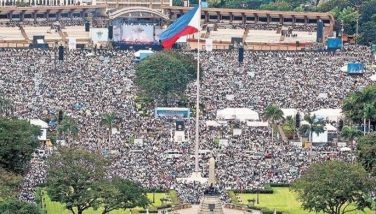Supporting our creative

In an article released around a year ago, the government estimated that the Philippines’ creative industry was set to see double digit growth over the next three years. Earlier this year, the Philippine Statistics Authority (PSA) provided the first hard numbers we can use to gauge the extent and economic impact of the nation’s creatives. According to that PSA data, there were 7.2 million people employed in the creative industries last year, up from a low of 5.5 million to which the number dipped during the beginning of the pandemic. Last year, the economic value of the creative industries – legally defined now under Republic Act 11904 as “trades involving persons, whether natural or juridical, that produce cultural, artistic and innovative goods and services originating in human creativity, skill and talent and having a potential to create wealth and livelihood through the generation and utilization of intellectual property” – amounted to P1.72 trillion, 7.1 percent of the country’s gross domestic product (GDP), showing a growth of 6.9 percent.
There is a growing appreciation for the creative work of Filipinos around the world. In practically every known artistic field – cinema, games, comics, music, literature, dance – Filipinos have distinguished themselves on a global stage in the recent past. The government seems to have also grown more aware of the need to support and nurture creative industries in the country, with the passage of laws such as Republic Act 11996 (the “Eddie Garcia Law”) which requires a formal employment contract for workers engaged in the movie and television industry; Republic Act 11961 (informally, the “Cultural Mapping Law”) which mandates the categorization, registration and preservation of cultural properties; as well as the aforementioned Republic Act 11904 or the “Philippine Creative Industries Development Act” (PCIDA). We have our determined champions for the creative industry to thank for the passage of these laws – foremost of which is Pangasinan Representative Christopher de Venecia, who has nurtured the growth of the PCIDA since its inception, to its passage and until its implementation.
However, as the government endeavors to create a better environment for artists, it must be careful not to make the mistake of equating commercial success or international recognition with the totality, or even the most urgent, of the needs of Philippine creatives. The creative spirit that so intensely drives men and women to work in their chosen fields is one which is directed to the creation of art, not to the manufacturing of a product. It is one of the laudable goals of the government to facilitate the creation of a system where artists can make a living from their art should they so choose, but that is different from equating art with consumer products, with pegging price as the sole evaluation of worth.
It can be said that a focus on creative industries is important and necessary for the growth of those industries, for streamlining procedures and better centralization and capacity-building. After all, while all art has the potential to inspire hearts and expand minds, it needs a way to reach an audience in order to have this effect. Providing a space for art, a means to display (such as galleries in the provinces) or distribute (as is always a problem with physical books) it and ways to promote its importance and availability – these are areas where State intervention can be an efficient and essential remedy. This was the purpose of the Creative Industries Development Act – but as the focus of that law is on creative industries as defined therein, there remains policy gaps that must still be addressed. After all, creative “industries” alone do not encompass the totality of the creative life of our citizens, nor does a focus on the same address all their needs as creators and human beings.
For instance, many creative workers are not part of formal organizations, but are freelancers, self-employed or informal workers – many of whom lack even the basic safeguards that the Eddie Garcia Law has managed to provide for employees in movie and television. There must be a way to bring these creative workers, these laborers, under the formal protections guaranteed by our laws, whether through involvement of agencies such as the Department of Labor and the Philippine Creative Industries Development Council (of which the DOLE is not currently represented under the law), or through some other legal framework. Rep. de Venecia filed the Freelance Protection bill which seeks to address this concern and I hope it becomes law.
There must also be a drive for members of a field to organize into groups that can better fight for individual rights, as well as participate in policy-making. Such organizations can make it easier to educate new members and to advocate for benefits as well as protection against both old and new threats or concerns. Old concerns include the need to provide more accessible training for those who wish to learn the art, and old threats include that of excessive censorship, which has been alleged of the film industry in recent months. As for new dangers, one of particular concern to many creatives is the danger posed by unethical and unregulated use of AI models, many of which are trained on the intellectual property of creators without their consent, and which can then be turned around and used as a means to undercut the compensation of human creators upon whose very labors these AIs were trained.
Finally, it must also be stressed that as beneficial as international recognition and availability is to our cultural work, this work must also be nurtured and supported here at home for it to truly bear fruit. Forays into international markets must at least be parallelled by efforts to foster the availability of, and the love for, Filipino creative work here at home. After all, much of what makes a Filipino work of art unique, what makes it stand out on the global stage, is the Filipino context in which it was created.
At the end of the day, the best and most sustainable way to support the creation of great Filipino works of art – of literature, of music, of theater, of games, of painting, of sculpture – is to make the Philippines into a country that values Filipino works of art, and supports the human beings that create them.
- Latest
- Trending




























